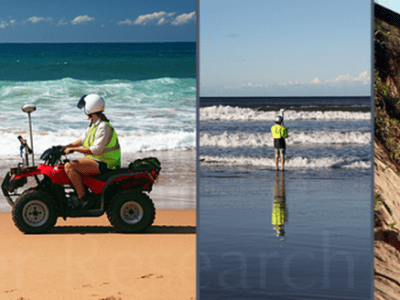COASTAL MONITORING

Australian Coastal Observation Network: Monitoring and Forecasting Coastal Erosion in a Changing Climate. Photo source: WRL, 2015.
Coastal monitoring was raised in a discussion last week at the phone hook-up of the ACS Executive. Questions were asked about who was monitoring what around the Australian coast, for how long, and for what purpose. It was apparent that a range of monitoring programs exist at local and state levels and by federal institutions and by universities. But is there any coordination or location where access to such information could be obtained, or even any standards for monitoring? Of course our national tidal system sits at one end on the monitoring spectrum along with measurements of ocean temperature reported in the national news last week for the east coast, but what else?
Long-term monitoring of environmental condition has absorbed much of my time over the years. I was first exposed to an already well established program run by Alec Costin of the then Alpine Ecology Unit of CSIRO in the Snowy Mountains. Several students were engaged each summer to measure plant recovery along set transects in areas from which stock had been excluded. Patterns of change were dutifully documented by Costin and colleagues in their seminal works. While in the USA in the 60s I observed attempts to monitor beach change at places like DUCK in North Carolina (and I also visited the Mauna Loa observatory just set up to measure greenhouse gases). While at ANU an opportunity to measure beach profiles presented itself to me in 1971 so a program of regular surveys was established north of the Moruya airport and continued to this day by Roger McLean. Andy Short set up a similar system at Narrabeen which has been continued by Ian Turner and colleagues from UNSW. These studies have led to a greater understanding of beach and foredune dynamics and have complemented other studies by individuals such as Ian Eliot and Pat Hesp, and institutions such as the much lamented Beach Erosion Board in Queensland and Gold Coast City Council.
With few exceptions, this type of monitoring has been championed by dedicated individuals who have a passion for understanding change over years. I was further reminded of this passion when I attended the Mangrove Workshop in February. Several papers discussed experiments to monitor potential impacts of sea level rise on mangrove surfaces. In the 70s AIMS with Army support built a magnificent board walk into the rich mangrove forest on Hinchinbrook Island. Champions for mangrove research at the time led by John Bunt were able to undertake a range of studies. If this field site had been maintained it could have provided a long-term base for many of the new generation of mangrove ecologists. But alas, the board walk no longer exists.
As a nation we are conscious of the need to monitor many atmospheric variables. Our forefathers saw this need when they included reference to the Bureau of Meteorology in the Constitution. But other matters related to environmental condition were essentially left to the states. Attempts have been made from time to time at consistent approaches and comparisons of data, but during my time as Chair of the 2001 National SOE Committee, I was struck by the reluctance of some states to provide data as well as differences in the way variables had been measured. The lack of agreement or even incentive to monitor environmental change in a coordinated way struck me as a real problem in the way we invest funds to manage degraded landscapes including coasts. Our work as members of the Wentworth Group on Environmental Accounts in recent years has reinforced this position. Increasingly, our understanding of climate change is driving our need to establish baselines from which change in environmental condition can be assessed. Many scientists in CSIRO, AIMs, ANSTO, GA and the universities appreciate this need and are putting in place actions to achieve improved appreciation of long-term change. The Academy of Science in 1992 put a costed submission to Federal Cabinet to establish a network of long-term ecological research stations to fill this gap. But investment in monitoring was not then and presumably now not the flavour of the month!
The model of national funding for long term environmental research based on selected field sites at sensitive locations is well known in the USA. On recent visits to the USA I have visited Michael Craghan of the EPA in Washington DC. He has oversight of an impressive federal supported National Estuaries Program. This is a cooperative program with state governments in estuaries that are declared of national significance. Numerous support mechanisms are available involving communities. Some estuaries are specifically monitored as “climate ready estuaries”. The program is expected to be sustained into the future; check outhttp://www.epa.gov/cre.
Perhaps the time has come again to appeal to governments to establish a level of coordination and investment in measuring indicators of change to environmental condition. Leadership at the federal level is critical as argued by the House Of Representatives coastal inquiry in 2009, and demonstrated in successive SOE reports.
Around the Australian coast we can identify a range of “sensitive sites”. Already we are investing in such work on the Great Barrier Reef, but there are many other areas where habitat and landform change deserves closer attention given the concentration of people and wealth on the coast, areas of vulnerability to sea level rise and other climate controlled factors, and desire of communities, coastal managers and scientists to see governments make commitments to the long-term interests of Australia.
– words by Prof. Bruce Thom


